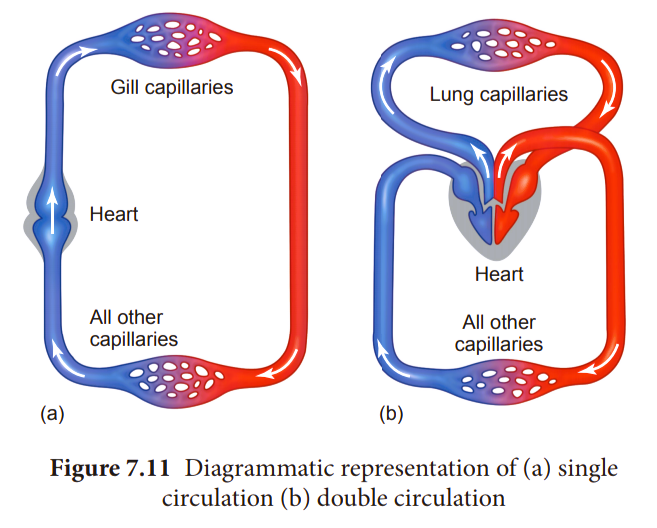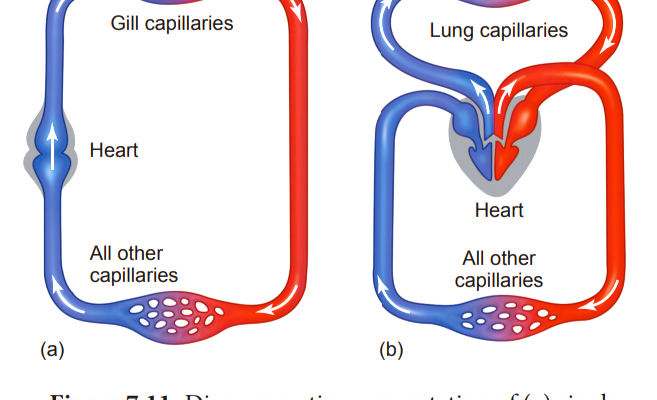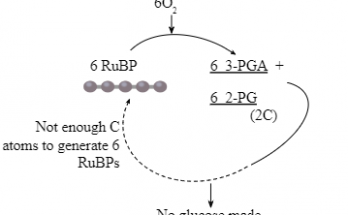The Circulatory System is responsible for transporting blood, nutrients and oxygen throughout the body. In vertebrates, the circulatory system can be divided into two main types –
- Single circulation
- Double circulation.
Table of Contents
Double Circulation and Single Circulation
Single Circulation is a type of closed circulatory system found in fish and some invertebrates, where blood flows through the heart only once to complete the circuit of the body. The heart in single circulation is two-chambered consisting of one atrium and one ventricle. Blood is transported only in the venous form i.e. deoxygenated blood. After oxygenation in the gills, blood does not return to the heart and is directly supplied to the body tissues. Single circulation is a less efficient system and blood flows at a low pressure.
Double Circulation is a type of closed circulatory system found in birds and mammals, where blood flows through the heart twice to complete the full circuit of the body. The heart in double circulation is four-chambered. It consists of two atria and two ventricles. Blood transports both oxygenated and deoxygenated blood. Blood is pumped from the lungs to the body tissues in the systemic circulation and from the body tissues to the lungs in the pulmonary circulation. Double Circulation is a more efficient system and blood flows at a high pressure.
Also Check – Double Circulation -Definition, 2 Loops, Flowchart,Types, Importance
Also Chekc – What is Double Circulation in Human Beings Why is it Necessary
Difference between Double Circulation and Single Circulation
| Factor | Single Circulation | Double Circulation |
|---|---|---|
| Definition | Blood flows through the heart only once to complete the circuit. | Blood flows through the heart twice to complete the full circuit. |
| Types of animals | Present in fish and some invertebrates. | Present in birds and mammals. |
| Pathways | Blood flows in a single pathway. | Blood flows in two pathways, pulmonary circulation and systemic circulation. |
| Oxygenation of blood | After oxygenation in the gills, blood does not return to the heart and is directly supplied to body tissues. | After oxygenation in lungs, blood comes back to the heart and then is pumped to different body parts through systemic circulation. |
| Chambers of heart | The heart is two-chambered, consisting of one atrium and one ventricle. | The heart is four-chambered, consisting of two atria and two ventricles. |
| Blood transported | Blood is transported only in the venous form, i.e., deoxygenated blood. | Blood transports both oxygenated and deoxygenated blood. |
| Efficiency of system | It is a less efficient systema nd blood flows at a low pressure. | It is a more efficient system and blood flows at a high pressure. |
Difference between Double Circulation and Single Circulation – Explained in Details

Differences between Double Circulation and Single Circulation in terms of Blood flow pathway-
Single circulation involves only one pathway for blood to flow through the body. In fishes, for example, the blood is pumped by the heart to the gills, where it is oxygenated, and then flows directly to the body tissues. In contrast, double circulation involves two separate pathways for blood flow, namely pulmonary and systemic circulation. Pulmonary circulation carries deoxygenated blood from the heart to the lungs for oxygenation and returns oxygenated blood back to the heart. Systemic circulation, on the other hand, carries oxygenated blood from the heart to the body tissues and returns deoxygenated blood back to the heart.
Also Check – Transportation in Human Beings
Differences between Double Circulation and Single Circulation in terms of Heart structure-
Single circulation is associated with a two-chambered heart, consisting of one atrium and one ventricle. This is because the system only needs to pump blood through one circuit and the simpler anatomy is sufficient for the needs of fish and other animals with single circulation. Double circulation is associated with a four-chambered heart, consisting of two atria and two ventricles. This is because the system needs to pump blood through two circuits and the more complex anatomy is necessary for the needs of animals with double circulation.
Differences between Double Circulation and Single Circulationin terms of Respiratory System
Double circulation is associated with a more complex respiratory system, as oxygen exchange occurs in the lungs. This is necessary for animals with higher oxygen requirements, such as birds and mammals.
Single circulation is associated with a simpler respiratory system, as the oxygen exchange primarily occurs in the gills. This is sufficient for the needs of fish and other animals with single circulation, but not for animals with higher oxygen requirements.
Differences between Double Circulation and Single Circulation in terms of Blood Pressure
Blood flows at a lower pressure in single circulation as compared to double circulation. This is because blood does not need to travel as far in single circulation and the heart does not need to work as hard to pump blood through the system.
Blood flows at a higher pressure in double circulation as compared to single circulation. This is because the heart needs to pump blood through two circuits and the oxygen requirements are higher, so the heart needs to work harder to pump blood through the system.
Also Check – Differences between Systolic and Diastolic Blood Pressure
Differences between Double Circulation and Single Circulation in terms of Blood type-
In single circulation, blood is transported only in the venous form, i.e., deoxygenated blood. In contrast, in double circulation, both oxygenated and deoxygenated blood circulate through the heart.
Differences between Double Circulation and Single Circulation in terms of Efficiency –
Double circulation is a more efficient system than single circulation. In double circulation, blood flows at a higher pressure that allows for faster and more efficient delivery of oxygen and nutrients to the body tissues. In single circulation, blood flows at a lower pressure that can limit the efficiency of oxygen and nutrient delivery.
Differences between Double Circulation and Single Circulation in terms of Types of Animals
Single circulation is found in fish and some invertebrates such as crustaceans and mollusks. This system is sufficient for their needs, as they have lower oxygen requirements compared to animals with double circulation.Double circulation is found in birds and mammals, as their higher oxygen requirements necessitate a more efficient circulatory system. This system allows for more efficient oxygen exchange and the transport of oxygenated blood to different parts of the body.
Also Check – Describe the Flow of Blood through the Heart of Human Beings
Similarities between Double Circulation and Single circulation
While there are several differences between double circulation and single circulation there are also some similarities that both systems share. Understanding these similarities can help us better appreciate the unique features of each system and how they contribute to the overall functioning of the organism.
Following are some similarities between double circulation and single circulation:
- Closed circulatory system- Both double circulation and single circulation are types of closed circulatory systems. This means that the blood flows through a network of blood vessels and is not directly exposed to the tissues in the body.
- Transport of nutrients and waste products – In both systems, the blood is responsible for transporting nutrients and oxygen to the body’s tissues and for removing waste products such as carbon dioxide.
- Use of a heart – In both systems blood is pumped through the circulatory system by the heart. In single circulation, the heart is typically two-chambered, while in double circulation its four-chambered.
- Use of arteries and veins – Both systems use arteries to transport blood away from the heart and veins to transport blood back to the heart.
- Maintenance of homeostasis – Both double and single circulation systems play a crucial role in maintaining homeostasis . It is the balance of internal conditions necessary for the body to function properly.
Frequently asked Questions on Difference between Double Circulation and Single Circulation
Question- Why does double circulation require a four-chambered heart, while single circulation only requires a two-chambered heart?
Answer- Double circulation requires a four-chambered heart because it needs to pump blood through two separate pathways (pulmonary and systemic circulation) to meet the higher oxygen requirements of animals like birds and mammals. Single circulation, on the other hand, only requires a two-chambered heart since it involves a simpler pathway and lower oxygen requirements.
Question- How does the respiratory system differ between animals with double circulation and those with single circulation?
Answer- Animals with double circulation, like birds and mammals, have a more complex respiratory system involving lungs, as they require higher oxygen exchange. In contrast, animals with single circulation, such as fish, have a simpler respiratory system where oxygen exchange primarily occurs in the gills.
Question- Why does blood flow at a higher pressure in double circulation compared to single circulation?
Answer- In double circulation, blood needs to be pumped through two circuits (pulmonary and systemic), which requires the heart to work harder, resulting in higher blood pressure. In single circulation, blood flows at a lower pressure as it does not need to travel as far and the system is less complex.
Question- What is the significance of blood type in double circulation compared to single circulation?
Answer- In single circulation, blood is primarily transported in the venous form (deoxygenated blood). In double circulation, both oxygenated and deoxygenated blood circulate through the heart, allowing for separate pathways and efficient delivery of oxygen to body tissues.
Question- How does the efficiency of oxygen and nutrient delivery differ between double circulation and single circulation?
Answer- Double circulation is considered more efficient because blood flows at a higher pressure, enabling faster and more effective delivery of oxygen and nutrients to the body tissues. In single circulation, the lower blood pressure can limit the efficiency of oxygen and nutrient delivery.
Question- Which types of animals have single circulation, and which have double circulation?
Answer- Single circulation is found in fish and some invertebrates (crustaceans and mollusks) due to their lower oxygen requirements. Double circulation is found in birds and mammals, as their higher oxygen requirements necessitate a more efficient circulatory system.
Question- What are the similarities between double circulation and single circulation in terms of the circulatory system?
Answer- Both double circulation and single circulation are closed circulatory systems, meaning that blood flows through a network of blood vessels and is not directly exposed to the tissues. Both systems also use arteries to transport blood away from the heart and veins to transport blood back to the heart.
Question- How does the complexity of the respiratory system relate to the oxygen requirements of an animal?
Answer- Animals with higher oxygen requirements, like birds and mammals, have a more complex respiratory system (lungs) to facilitate efficient oxygen exchange. In contrast, animals with lower oxygen requirements, such as fish, have simpler respiratory systems like gills.
Question- How do double circulation and single circulation contribute to maintaining homeostasis?
Answer- Both double and single circulation systems play a crucial role in maintaining homeostasis, which is the balance of internal conditions necessary for the body to function properly. They transport nutrients, oxygen, and remove waste products like carbon dioxide, ensuring the body’s systems operate within the required parameters.
Question- How does the number of chambers in the heart relate to the type of circulation?
Answer- Animals with single circulation typically have a two-chambered heart, while animals with double circulation have a four-chambered heart. The additional chambers in a four-chambered heart allow for the separation of oxygenated and deoxygenated blood, enabling efficient double circulation.


4 Comments on “Difference between Double Circulation and Single Circulation”